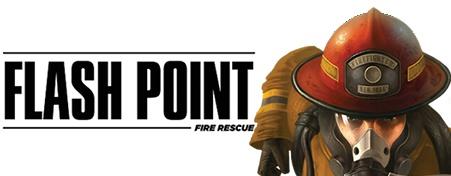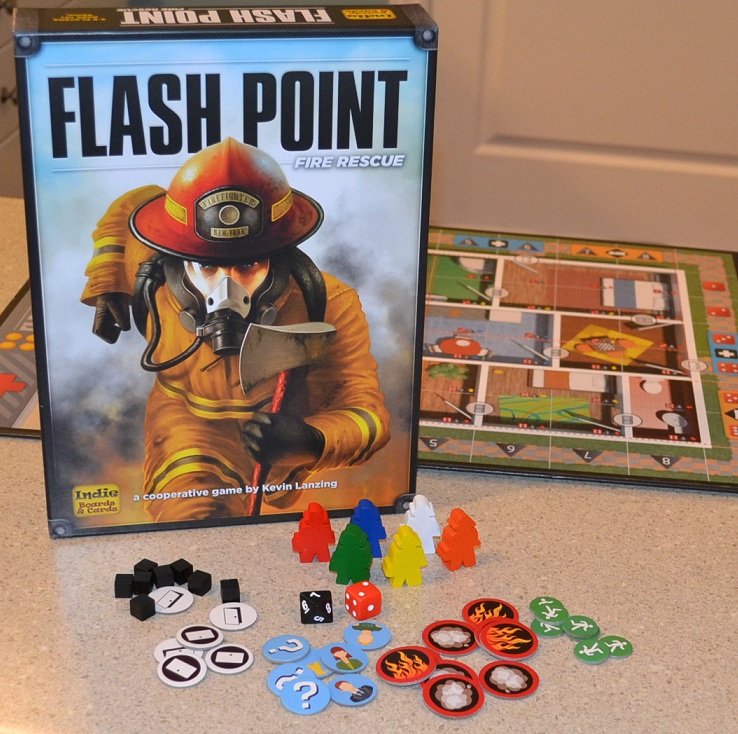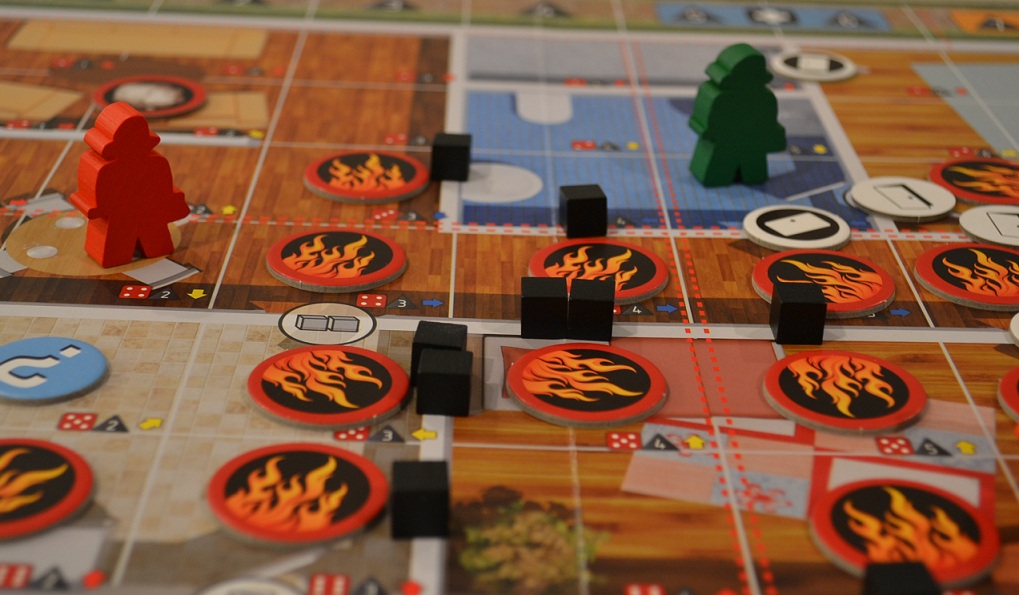 It seems that January put me
on a Kickstarter mood. We covered the ENWorld and The Dice Tower Kickstarters, and yesterday’s post is about a
Kickstarter project that was successfully funded in May of last year: the open beta
test of the Pathfinder-based steampunk RPG Pure Steam. Flash Point, believe it or not, is also the
result of a Kickstarter project and one awesome cooperative game.
It seems that January put me
on a Kickstarter mood. We covered the ENWorld and The Dice Tower Kickstarters, and yesterday’s post is about a
Kickstarter project that was successfully funded in May of last year: the open beta
test of the Pathfinder-based steampunk RPG Pure Steam. Flash Point, believe it or not, is also the
result of a Kickstarter project and one awesome cooperative game.
 If you follow this blog you
know how much I enjoyed Pandemic and how highly I recommend it. Flash Point: Fire Rescue is published by Indie Boards and Cards, and while the mechanics of its beginner/family game are much
simpler than Pandemic’s, the game is just as much fun and probably more
challenging than Pandemic. Let me put
this last statement in perspective: while I have won several games of Pandemic
in normal mode, I have yet to win one of Flash Point using the family rules.
If you follow this blog you
know how much I enjoyed Pandemic and how highly I recommend it. Flash Point: Fire Rescue is published by Indie Boards and Cards, and while the mechanics of its beginner/family game are much
simpler than Pandemic’s, the game is just as much fun and probably more
challenging than Pandemic. Let me put
this last statement in perspective: while I have won several games of Pandemic
in normal mode, I have yet to win one of Flash Point using the family rules.  Need to hear more accolades
about Flash Point? Flash Point: Fire
Rescue was a runner up for the following awards for games published in 2011:
Best Family Game and Best Game Artwork. It also won awards for Best New Game Designer,
Best Game Theme and Best Small Publisher.
Need to hear more accolades
about Flash Point? Flash Point: Fire
Rescue was a runner up for the following awards for games published in 2011:
Best Family Game and Best Game Artwork. It also won awards for Best New Game Designer,
Best Game Theme and Best Small Publisher.
The premise of Flash Point is
quite unique. The players are firemen
tasked with saving the lives of seven victims located in randomly spawning
locations inside a burning building, and they must do this before the fire kills four victims or the
building comes down on everyone inside it.
 To save a victim, you simply carry her outside of the burning building. However, this is a bit harder than it sounds. Victims are represented by blue discs called Point of Interest ("POI") markers. On one side they have a white question mark
and they are placed randomly in the burning building with the question mark
side up. On the opposing side, the blue
disc has a victim or is blank. This
means that after spending several turns fighting fire and chopping walls, the players may find that their efforts to save a victim were all for naught.
To save a victim, you simply carry her outside of the burning building. However, this is a bit harder than it sounds. Victims are represented by blue discs called Point of Interest ("POI") markers. On one side they have a white question mark
and they are placed randomly in the burning building with the question mark
side up. On the opposing side, the blue
disc has a victim or is blank. This
means that after spending several turns fighting fire and chopping walls, the players may find that their efforts to save a victim were all for naught.
 To save a victim, you simply carry her outside of the burning building. However, this is a bit harder than it sounds. Victims are represented by blue discs called Point of Interest ("POI") markers. On one side they have a white question mark
and they are placed randomly in the burning building with the question mark
side up. On the opposing side, the blue
disc has a victim or is blank. This
means that after spending several turns fighting fire and chopping walls, the players may find that their efforts to save a victim were all for naught.
To save a victim, you simply carry her outside of the burning building. However, this is a bit harder than it sounds. Victims are represented by blue discs called Point of Interest ("POI") markers. On one side they have a white question mark
and they are placed randomly in the burning building with the question mark
side up. On the opposing side, the blue
disc has a victim or is blank. This
means that after spending several turns fighting fire and chopping walls, the players may find that their efforts to save a victim were all for naught.  This image shows the starting set up for the family rules game. The house is already on fire and there are three points of interest in the house. All doors inside the house are closed and all walls are undamaged. Firemen start at the square of their choice outside the house. See the red and black numbers on the blocks outside the house? You'll be rolling a red six-sided die and a black eight-sided die for the location where the fire will spread and where new POIs will appear.
This image shows the starting set up for the family rules game. The house is already on fire and there are three points of interest in the house. All doors inside the house are closed and all walls are undamaged. Firemen start at the square of their choice outside the house. See the red and black numbers on the blocks outside the house? You'll be rolling a red six-sided die and a black eight-sided die for the location where the fire will spread and where new POIs will appear.The game is pretty simple in its basic/family rules inception. Each turn consists of 3 phases: (i) Take Action, (ii) Advance Fire and (iii) Replenish POI.
TAKE ACTION
Players have 4 action points ("AP") they can spend every turn in order to Move, Open/Close Doors, Extinguish or Chop, but do not need to spend all of them. In fact, sometimes you will not be able to spend all your AP. Fortunately, players can save up to 4 unused AP and spend them later, as they see fit. Actions costs in AP are as follows:
Move - Move your fighter to an adjacent space:
- To a space without Fire: 1 AP.
- To a space with Fire: 2 AP.
- Carry a victim to an open space or space with Smoke: 2 AP.
- If you move into a space with a POI, flipping it costs 0 AP.
Open/Close Door - Flip a door marker in your space: 1 AP.
Extinguish - Fight the fire in the firefighter's space or an adjacent space:
- Remove a Smoke marker from the board: 1 AP.
- Flip a Fire marker to Smoke: 1 AP.
- Remove a Fire marker from the board: 2 AP.
Chop - Damage a wall to reach a trapped victim or create an escape route from the building:
- Place a Damage marker (these are small black cubes) on a wall segment in your space: 2 AP.
 A wall segment with 2 Damage markers is destroyed and players may pass through it freely. However, when there are no Damage markers left, the structural integrity of the building has been compromised and the building collapses killing everyone still in it.
A wall segment with 2 Damage markers is destroyed and players may pass through it freely. However, when there are no Damage markers left, the structural integrity of the building has been compromised and the building collapses killing everyone still in it.
ADVANCE FIRE
After taking Actions, the current player rolls the dice to Advance the Fire and places a Smoke marker in the space corresponding to the numbers rolled on the dice, also known as the Target space. Smoke, as we quickly learned, can be a dangerous thing. After placing the Smoke marker, you check for the following conditions:
After taking Actions, the current player rolls the dice to Advance the Fire and places a Smoke marker in the space corresponding to the numbers rolled on the dice, also known as the Target space. Smoke, as we quickly learned, can be a dangerous thing. After placing the Smoke marker, you check for the following conditions:
- If the Smoke is placed on an existing Smoke - flip one smoke marker to a Fire and remove the second Smoke marker; Smoke + Smoke = Fire.
- If the Smoke is placed adjacent to a Fire - flip the Smoke to Fire; Smoke adjacent to Fire = Fire.
- If the Smoke is placed on an existing Fire - You have just caused an Explosion!
Explosions
If you have played Pandemic, an Explosion is the equivalent of an Epidemic card. Explosions spread fire quickly, can damage walls and doors, Knock Down firefighters and even kill victims. Unlike Epidemic cards, you cannot remove Explosions from the board before the start of the game in order to control the difficulty level. Players must work as a team to control the spread of fire as an Explosion can occur at any time, wherever there is a Fire marker.
If you have played Pandemic, an Explosion is the equivalent of an Epidemic card. Explosions spread fire quickly, can damage walls and doors, Knock Down firefighters and even kill victims. Unlike Epidemic cards, you cannot remove Explosions from the board before the start of the game in order to control the difficulty level. Players must work as a team to control the spread of fire as an Explosion can occur at any time, wherever there is a Fire marker.
An Explosion radiates Fire in all four directions from the Target space (no diagonals allowed in this game). You place a Fire marker in each space adjacent to the Target space or flip the Smoke marker to Fire in a Smoke filled space. You also place a Damage marker on all the walls that border the Target space and remove any door markers that border said space. However, if the adjacent space in any direction is already on Fire, a Shockwave is created!
Shockwave
A Shockwave continues to travel in its respective direction passing through all the spaces that are on Fire until it either encounters an open space, Smoke filled space, wall or closed door (it continues traveling through open doors). Depending on what the Shockwave hits first, the following can happen:
Shockwave
A Shockwave continues to travel in its respective direction passing through all the spaces that are on Fire until it either encounters an open space, Smoke filled space, wall or closed door (it continues traveling through open doors). Depending on what the Shockwave hits first, the following can happen:
- Open Space - place a Fire marker in the open space, even if that space is outside the building.
- Smoke Filled Space - flip the smoke marker to Fire.
- Wall - place a Damage marker on the wall. A wall that has 2 Damage markers is destroyed and will not stop a Shockwave.
- Closed Door - remove the door marker from the board; it has been destroyed.
After you have Advanced the Fire and resolved Explosions and Shockwaves, you check to see what damage has occurred. This could be a room full of Smoke turning into Fire, losing victims or firefighters getting Knocked Down.
Flashover - flip all Smoke markers that are adjacent to a Fire marker until there are no Smoke markers adjacent to Fire markers; Smoke adjacent to Fire = Fire, remember? Any firefighters in a space with Fire are Knocked Down. Any victims or POI in a space with Fire are lost.
Knocked Down - a firefighter is Knocked Down when Fire advances into his space. This can be the result of an Explosion, Shockwave or Fire Advance. When a firefighter is Knocked Down, he is removed from inside the building and placed in the closest ambulance parking spot to recover. In his next turn, he must work his way back into the burning building. Unfortunately, if the Knocked Down firefighter was carrying a victim, the victim is lost.
Replenish POI
After all the above has been checked for and resolved, you replenish any POI that has been removed from the building, whether they were false alarms or victims that were lost or rescued. There should always be 3 POI on the building.
That's the basic game! It is, in all sense of the phrase, deceivingly simple. As with Pandemic, there are many ways to lose but only one way to win. You lose when you run out of black Damage makers, which causes the building to collapse, or when you lose 4 victims. Victory is achieved only by rescuing 7 victims.
ACTUAL GAME PLAY
Initially, our strategy has been to go straight for the POIs and fight the fires we encounter on our way in and out out of the building. This strategy has proved to be a total failure. We are convinced that one or more players have to dedicate their efforts to fighting the fire while the others rescue the victims.
The problem lies in the increasing amount and proximity of the fire. Remember, fire advances after every player's turn. As the amount of building space that is on fire increases, so does the likelihood that an explosion and subsequent shockwave will take place. Explosions spread the fire in four directions. This means that after every explosion, there will be more spaces on fire and, thus, the likelihood of future explosions and shockwaves keeps increasing.
Shockwave complicates matters because it causes the explosion to travel through burning spaces until it finds a wall, door or empty space. Before long, explosions in one side of the building produce shockwaves that are felt all the way at the other end of the building. While these shockwaves will knock down firefighters and kill victims, our experience is that their real danger lies in the damage they do the building walls. Before long, you will find yourself running out of Damage markers in a building full of Fire markers and praying to gods you never knew existed so that the next Advance Fire does not result in an explosion/shockwave that collapses the building on you, your teammates and the victims.
 Why do I say that the structural damage caused by explosions and shockwaves are the real danger? Because every single game of Flash Point my group has played was lost when we ran out of Damage markers. Allow me to include some pictures to illustrate the point.
Why do I say that the structural damage caused by explosions and shockwaves are the real danger? Because every single game of Flash Point my group has played was lost when we ran out of Damage markers. Allow me to include some pictures to illustrate the point.
As you can see in this picture, we did not do a good job of controlling the fire, which has spread all throughout the building. More importantly, there is only 1 Damage marker left. With about half the building on fire, there's about a 50/50 chance that the Advance Fire will result in an explosion. Since the fire is all clustered together, the explosion will result in shockwaves that will spread in all four directions. I, as the blue firefighter, am hoping that I can exit the building with the victim I am carrying.
 Unfortunately, the dice for the Advance Fire phase were 2-black and 6-red. That is the square to the left of the blue fire fighter, where a Fire marker is already located. The resulting explosion knocks down the blue fighter, kills the victim the blue firefighter was carrying to safety and damages the building wall adjacent to the Target space. That was the last Damage marker. The building collapsed and we lost the game.
Unfortunately, the dice for the Advance Fire phase were 2-black and 6-red. That is the square to the left of the blue fire fighter, where a Fire marker is already located. The resulting explosion knocks down the blue fighter, kills the victim the blue firefighter was carrying to safety and damages the building wall adjacent to the Target space. That was the last Damage marker. The building collapsed and we lost the game.
In conclusion, Flash Point is an excellent game with very simple rules and very challenging victory conditions. When playing for the first time with a group of 15-year old kids, they constantly kept remarking how intense the game was. If you like cooperative games or are looking for an easy introduction to cooperative gaming, this is the game you were waiting for. Flash Point has quickly become one of my favorite games, right there with Pandemic.
Flashover - flip all Smoke markers that are adjacent to a Fire marker until there are no Smoke markers adjacent to Fire markers; Smoke adjacent to Fire = Fire, remember? Any firefighters in a space with Fire are Knocked Down. Any victims or POI in a space with Fire are lost.
Knocked Down - a firefighter is Knocked Down when Fire advances into his space. This can be the result of an Explosion, Shockwave or Fire Advance. When a firefighter is Knocked Down, he is removed from inside the building and placed in the closest ambulance parking spot to recover. In his next turn, he must work his way back into the burning building. Unfortunately, if the Knocked Down firefighter was carrying a victim, the victim is lost.
Replenish POI
After all the above has been checked for and resolved, you replenish any POI that has been removed from the building, whether they were false alarms or victims that were lost or rescued. There should always be 3 POI on the building.
That's the basic game! It is, in all sense of the phrase, deceivingly simple. As with Pandemic, there are many ways to lose but only one way to win. You lose when you run out of black Damage makers, which causes the building to collapse, or when you lose 4 victims. Victory is achieved only by rescuing 7 victims.
ACTUAL GAME PLAY
Initially, our strategy has been to go straight for the POIs and fight the fires we encounter on our way in and out out of the building. This strategy has proved to be a total failure. We are convinced that one or more players have to dedicate their efforts to fighting the fire while the others rescue the victims.
The problem lies in the increasing amount and proximity of the fire. Remember, fire advances after every player's turn. As the amount of building space that is on fire increases, so does the likelihood that an explosion and subsequent shockwave will take place. Explosions spread the fire in four directions. This means that after every explosion, there will be more spaces on fire and, thus, the likelihood of future explosions and shockwaves keeps increasing.
Shockwave complicates matters because it causes the explosion to travel through burning spaces until it finds a wall, door or empty space. Before long, explosions in one side of the building produce shockwaves that are felt all the way at the other end of the building. While these shockwaves will knock down firefighters and kill victims, our experience is that their real danger lies in the damage they do the building walls. Before long, you will find yourself running out of Damage markers in a building full of Fire markers and praying to gods you never knew existed so that the next Advance Fire does not result in an explosion/shockwave that collapses the building on you, your teammates and the victims.
 Why do I say that the structural damage caused by explosions and shockwaves are the real danger? Because every single game of Flash Point my group has played was lost when we ran out of Damage markers. Allow me to include some pictures to illustrate the point.
Why do I say that the structural damage caused by explosions and shockwaves are the real danger? Because every single game of Flash Point my group has played was lost when we ran out of Damage markers. Allow me to include some pictures to illustrate the point.As you can see in this picture, we did not do a good job of controlling the fire, which has spread all throughout the building. More importantly, there is only 1 Damage marker left. With about half the building on fire, there's about a 50/50 chance that the Advance Fire will result in an explosion. Since the fire is all clustered together, the explosion will result in shockwaves that will spread in all four directions. I, as the blue firefighter, am hoping that I can exit the building with the victim I am carrying.
 Unfortunately, the dice for the Advance Fire phase were 2-black and 6-red. That is the square to the left of the blue fire fighter, where a Fire marker is already located. The resulting explosion knocks down the blue fighter, kills the victim the blue firefighter was carrying to safety and damages the building wall adjacent to the Target space. That was the last Damage marker. The building collapsed and we lost the game.
Unfortunately, the dice for the Advance Fire phase were 2-black and 6-red. That is the square to the left of the blue fire fighter, where a Fire marker is already located. The resulting explosion knocks down the blue fighter, kills the victim the blue firefighter was carrying to safety and damages the building wall adjacent to the Target space. That was the last Damage marker. The building collapsed and we lost the game.In conclusion, Flash Point is an excellent game with very simple rules and very challenging victory conditions. When playing for the first time with a group of 15-year old kids, they constantly kept remarking how intense the game was. If you like cooperative games or are looking for an easy introduction to cooperative gaming, this is the game you were waiting for. Flash Point has quickly become one of my favorite games, right there with Pandemic.


No comments :
Post a Comment